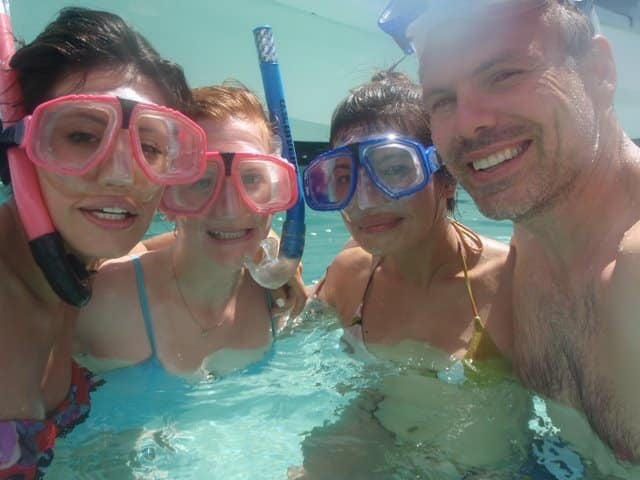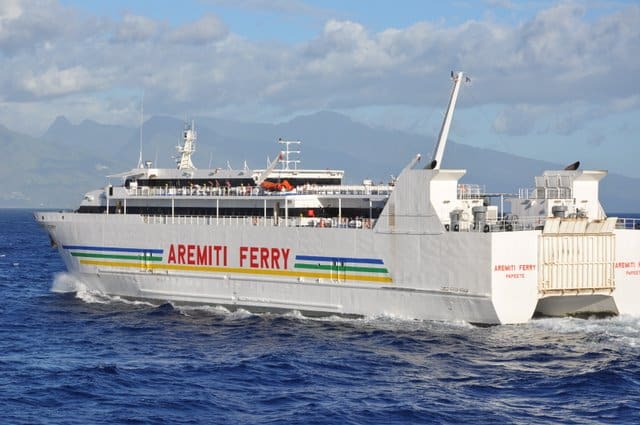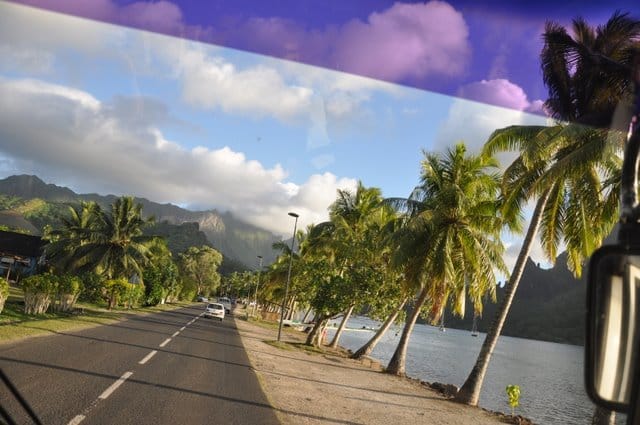
Ia Orana! We left off last week after touring around the island of Tahiti and its capital city, Papeete. This week we travel across the Sea of Moon to the island of Moorea! If you want to see one of the world’s most gorgeous islands, then pack your bathing suit, sunscreen, and let’s go–the ferry is leaving. If Moorea is too touristy for you, then be sure to check out part two of writer/photographer Jerome Shaw’s story about his multi-week cruise on a cargo ship that makes stops at French Polynesia’s remote islands.
PAPEETE TO MOOREA
The island of Moorea is 12 miles from Papeete, and travelers can either take an exciting six-minute flight (on Air Tahiti or Air Moorea) or take a ferry across the Sea of Moon. The slow ferry takes an hour, and the fast one cuts the time almost in half. No reservation is needed; a one-way adult ticket for the 30-minute ferry goes for 1,800 XPF (US$20).
CURRENCY
Currently, the conversion is US$1 = 91.6 XPF.
AREMITI FERRY
Our ferry left right at 4 p.m. –how’s that for island time? Actually, pretty much everything (guides, vans, boats, planes . . . ) left when it was scheduled to, which is unusual in a tropical place. Usually, the locals are so laid-back that they take their sweet old time and create their own schedules. But that doesn’t seem to be the case here. The name of the high-speed car ferry was Aremiti 5 catamaran. It’s huge with comfortable seats, air-conditioning, bathrooms, and a snack bar. The top deck has open-air seating, and it’s so nice to sit outside.
NO SEASICKNESS HERE
The boat did rock a bit, but it’s only a 30-minute trip. To combat feeling seasick, the best thing to do (besides taking medication or using gadgets) is to sit upstairs and stare out at the horizon. FYI: I didn’t see anyone get sick, so I wouldn’t really worry about it.
ABOUT MOOREA
Also known as the Island of Love, Moorea is a Windward Island and part of a larger archipelago of islands called the Society Islands. It’s simply one of the most beautiful places on earth with its jagged, lush green mountain ranges, palm trees, flowers, and, of course, the incredible shades of blue water. It’s not only breathtaking; it’s surreal. It’s no wonder that it was the inspiration for many works by French impressionist artist Paul Gauguin.
HILTON MOOREA LAGOON RESORT & SPA
On my last two trips, I stayed at the Moorea Pearl Resort and Spa, but this time I drove right by it on the way to the Hilton, which is a good 20 minutes from the ferry. The Hilton Moorea Lagoon Resort & Spa has 100 rooms. Half of them are on land, and the other half are over the water. Obviously, the place to be is over the water, unless you are traveling with little kids–then you would probably want a garden bungalow.
GET A PACKAGE DEAL
Garden Bungalows ($500) are usually half the price of the overwater bungalows ($1,000), if booking directly with the hotel. But unless you are cashing in your Hilton Honors points for a free room, it would be a mistake to book direct. The best deals to French Polynesia are package deals that include air, room, and transfers, so don’t get scared when you read the rack rates above. When I book my trips, I always consult with my Tahiti Islands travel agent, Jean-Louis Delezenne (meherio@yahoo.com).
GARDEN BUNGALOWS
I was put up in a garden bungalow, which is too bad because there’s really nothing like sleeping in an overwater bungalow and listening to the water slowly roll underneath you. FYI: There are no big waves, since they are built on crystal-clear calm lagoons. I was in bungalow 5, which along with the rest of the bungalows numbered 1 through 12 has to be the hotel’s worst because of its location–right next to the road. Instead of going to bed listening to the water, I heard cars drive by (not a lot) and one rambunctious rooster who mistook the full moon for daylight. But I’m a heavy sleeper, so I slept well, and the bed was comfortable (not the pillows–too bulky). Light sleepers should always bring earplugs and an eye mask.
ROOM DESIGN
All the rooms feature a contemporary Polynesian design and are generous in size: a total of 1,712 square feet, including the private terrace and plunge pool that comes with each garden bungalow. Inside, there’s a 37-inch flat-screen TV with 13 channels–half of them in English, including CNN, Cartoon Network, and TCM. Wireless high-speed Internet access is available but costs 500 XFP (US$5.45) for one hour, 2,000 XFP (US$21) for five hours, and it’s not terribly fast. The bathroom is modern, with a separate bathtub and shower with lots of shelf space and a huge rain showerhead. But they only give you one bar of soap, so you need to choose whether to leave it next to the sink or in the shower. NOTE: The shower does have bath wash, but I’m a bar-soap kind of guy.
DID YOU KNOW: The overwater bungalow was created in French Polynesia by three guys from California (Jay, Muk, and Hugh). They built the first one in 1968 on the island of Raiatea. Now you can find them not only all over the South Pacific, but all over the world.
TWO ROOMS ARE BETTER THAN ONE
All the bungalows except for the presidential suite have an adjoining room/terrace, so it’s ideal if you are booking two rooms–one for the adults and one for the kids, for example. I found the walls to be a little thin, however, and I could hear the shower running and the phone ringing in my neighbor’s room–good thing it wasn’t a honeymoon couple next door.
ROOM/HOTEL RANDOM NOTES
-The windows have screens, so you can open the wood blinds, but there’s no screen door.
-The a/c was a little difficult to operate at first.
-The room has outlets for European-style electrical plugs, so bring an adapter.
-The maids don’t change the sheets unless you ask, which is great.
-The Tahitian night maids (there are two of them) leave the door wide open when doing their one-minute turndown. I kindly asked them to keep the door closed, so the lights wouldn’t attract mosquitoes.
-The staff are friendly and efficient.
-The hotel offers free kayaks and snorkel gear.
SUNRISE

The time change works in favor of those traveling west: You go to sleep early and wake up early. Because of that, the days feel so much longer, even though the sun sets around 6:30 p.m. all year round. I got up every morning to try and find that annoying rooster so I could wring its neck (just kidding). I really got up to see the sunrise, which never disappointed. Not once did I see another hotel guest out that early, and it was so private, quiet, and peaceful. The water was like glass, so when I walked down the wooden paths of the overwater bungalows I could admire the colorful fish and take in all the jaw-dropping views.
JAN PRINCE
What’s unique is that the hotel has (supposedly) the first overwater bar-restaurant, which is in the center of the bungalows. It’s only open in the evening, and in addition to drinks they serve crepes. I dined there one night with Jan Prince, who’s probably Tahiti’s most knowledgeable resident; she is the author of Tahiti & French Polynesia Guide. I learned all about her fascinating life while munching on cheese crepe appetizers (awesome), a chicken curry crepe for dinner (OK) and then devouring a banana-Nutella crepe for dessert (really good!). Apart from all the stars, and the moon shining so bright that you felt like you could reach up and touch them, the most exciting thing was watching the small sharks circle below. So cool!
HILTON BREAKFAST
Speaking of food, the Hilton had decent meals. My favorite was the breakfast buffet in their Arii Vahine restaurant. They had a nice selection of Polynesian and international cuisine and pastries (including evil brownies ). All the usual breakfast fixings were available, including made-to-order omelets. The only thing I don’t like about Hilton’s breakfast is their Trivial Pursuit–looking information cards that are placed next to each item–they have this at all of their hotels, and it drives me crazy it’s so tacky. The juices (mango, papaya, orange) and the fruit selection were also a bit of a disappointment, but the view and Tahitian coffee sure made up for it.
DINNER ON THE BEACH
One of the most memorable dinners was on the beach, which they do for special occasions for groups or a romantic dinner for two. Once a week they have a Polynesian show, which is always fun to check out.
LUNCH BY THE POOL
For lunch, I usually ate poolside at Rotui Grill. They have everything from cheeseburgers and pasta to fresh fish. The food is standard, but the view is not. What’s also not standard are the fruit drinks, which they make fresh from island ingredients.
DINING OUT

In French Polynesia, pretty much everything is expensive. The best bargains on food on Moorea are the food trucks and the grocery stores that sell fresh baguettes and provisions. BTW: Most supermarkets in French Polynesia are owned by the Chinese. What’s nice is that almost all the restaurants will provide transportation to and from your hotel free of charge; to get a list of the best restaurants either ask your concierge or email Jean-Louis Delezenne (meherio@yahoo.com).
SEEING THE ISLAND
Most people who come to the Society Islands are not going to want to do a lot of sightseeing. There’s not that much to see, and besides, your hotel and room will probably be so nice, all you’ll want to do is relax and enjoy the view and the water. However, Moorea might be the exception. You definitely want to spend a few hours checking it out. The island is easy to navigate, since it basically has one main road that circles the island along the ocean. It’s appropriately called Round Island Road. On my first trip here, I rented a car and made the loop around the 36-mile island. It took about four hours, since I took my time and stopped at some scenic spots and stores.
LAND TOURS
This trip, I needed to catch up on my work, so I passed on the Jeep Safari Tour of Moorea offered by Tora Nui Tours. I was bummed to miss it, because when my group of friends returned they said they had an incredible time and loved exploring the pineapple fields; seeing the different lookout points, including the famed Bali Hai; and visiting a rum distillery. I basically did the same tour two years ago, but on an ATV (All Terrain Vehicle, sometimes called a quad) excursion, organized by Albert Transports (Tel.: 77 47 21). Both tours take four hours; to read my stories and see pictures from that trip, click this link.
DID YOU KNOW?
-Just like in the U.S., only the rich folks live on the water. Everyone else lives inland. Just 15,000 people live on Moorea, and it’s so safe (there aren’t even any dangerous animals or insects) that the island has only 15 cops.
-Food is so expensive here, it’s cheaper to buy New Zealand–grown fruits, veggies, and meat. And Auckland is a five-hour flight away! Tahitians have to pay the same prices as tourists; unlike on many other island destinations, they don’t get local discounts.
-The Tahitians I spoke to gave me the impression that they don’t like the French that much, because they take the good jobs and they make everyone speak French.
BLUE WATER/SKIES
I couldn’t pass up on doing a ray-feeding excursion. The hotel arranged the tour, so we departed directly from the hotel pontoon in their boat. Be sure to pick up the free snorkeling equipment at the pool and bring water shoes, hat, sunglasses, and sunscreen. Cruising on French Polynesia’s clear blue water on a sunny calm day is magical–the beauty is just overwhelming.
FEEDING STINGRAYS
Our first stop was to feed the stingrays and blacktip reef sharks about a 20-minute ride away. I’ve done this before in Bora Bora (and will do it again next week), so I know what a good tour is like, and this wasn’t one of them. It was actually tourism at its worst, as boatload after boatload of people from all over the world kept showing up and trying to get the attention of the dozen or so stingrays and sharks. Instead of this tour, I highly recommend Dr. Michael Poole’s Dolphin- and Whale-Watching excursion, which I did two years ago. To read about Dr. Poole, click this link and scroll down.
DID YOU KNOW: There are 75 different species of whales in the world, and the waters around Moorea have 25 of them!
SNORKELING

Our guide from the hotel was embarrassed by all the tourists–including this lady who was screaming her head off (see this video) every time a stingray came close. The best part of our tour was when we packed up the boat and went 10 minutes farther away to a semi-private snorkeling spot nestled between two motus (small islands). We all grabbed our snorkeling gear and walked down the beach, and then floated with the current back toward the boat a good couple hundred yards away. It was much more relaxing, and although I didn’t see too many impressive fish or coral it didn’t matter because the water temperature was perfect. When we were done, they had fresh sliced pineapple and homemade lemonade waiting for us.
VIDEO
Here are the two-minute Johnny Jet videos of my previous trips to French Polynesia. We have also posted on YouTube all the Johnny Jet videos ever made.
NEXT WEEK
The beautiful island of Bora Bora. Stay tuned.
*PLEASE tell us what you think of this week’s newsletter!
Note: This trip was sponsored in part by Hilton Moorea Lagoon Resort & Spa




































